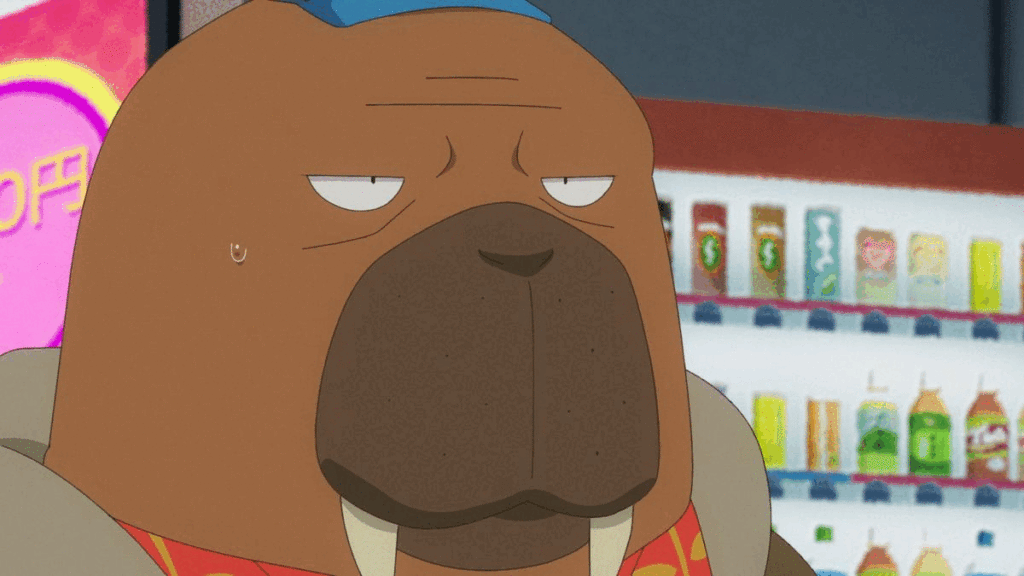
Folks, I’m not gonna lie, I have no idea where to start this script.
Well, I suppose I should start with the obvious – it’s February now. A time when most have already published their best of lists and moved onto the current agenda. By the time you read this, it will have been three weeks since I started drafting this intro. Initially, I had a lot of ground I wanted to cover – the state of the anime industry, the questionable business practices and lack of accountability, and the various unmitigated disasters that played out in real time – but even without the looming threat of an ongoing pandemic, 2021 kinda sucked in general.
Fortunately, 2021 was also one of the most packed years in terms of the anime that delivered. Of the 30 entries I had in my first draft, this is the highest number of nominations I’ve had since starting at AniTAY. It was a daunting task to narrow it down to just 10, but even harder was trying to find a commonality or a unifying theme that best encapsulates the year. Looking at the final list, there’s not a whole lot of common ground. Sci-fi, romance, horror, action, music, extreme sports, and at least one or two dark horses (except that one). In the end, I just settled on reminding myself of why I still do this in the first place. So, let’s not waste any more time.
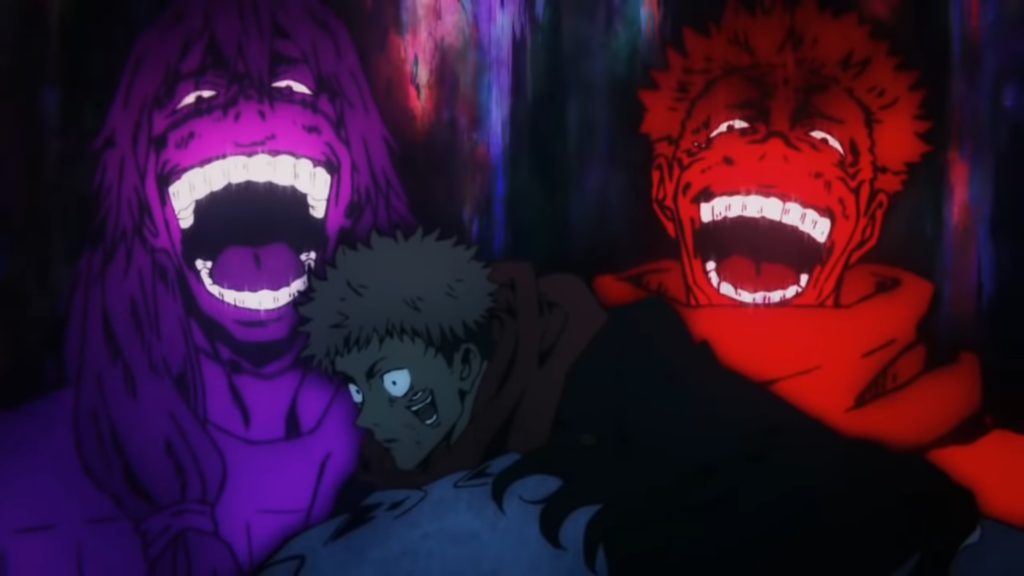
These are my Top 10 Anime of 2021:
***Per usual, only titles that completed their runs in the qualifying year are considered for this list, as I don’t believe in handing a final verdict without seeing the finished product. Shows like Ranking of Kings will qualify in 2022 (don’t worry, I haven’t forgotten!). Movies, OVAs, and specials are permitted, though none made it in this time.***
10. Sakugan
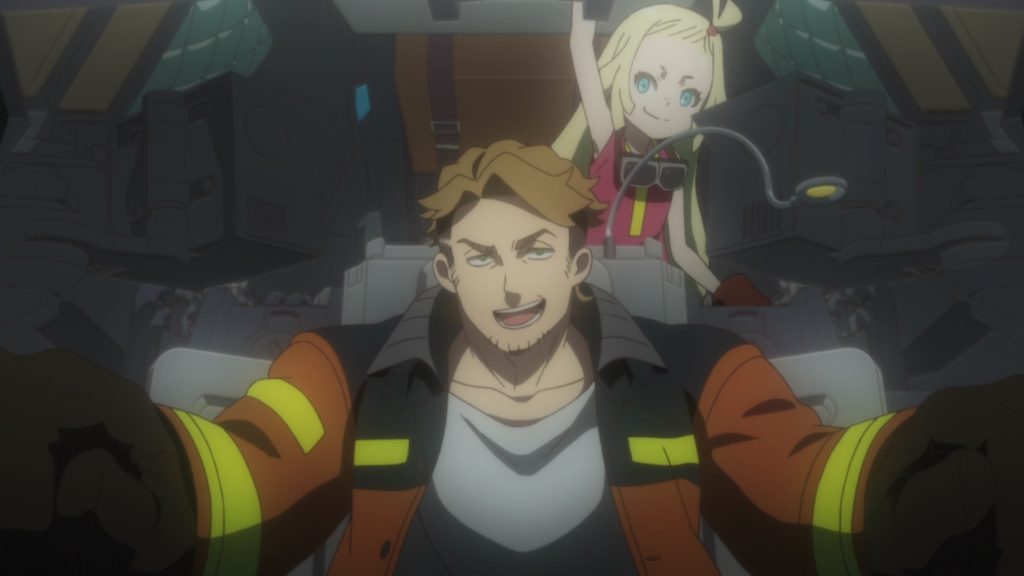
Similar to last year, I had a very difficult time deciding how to start this list. I usually have a pretty good idea of my top 3, but as I work on my rankings in reverse, that’s where trouble begins. The “best” of the year doesn’t leave much room for nuance, which about accurately sums up my feelings on Sakugan (Satelight). An anime adaption of the novel Sakugan Labyrinth Marker written by Nekotarō Inui, this stargazed labyrinthine adventure is relatively straightforward in its approach. A former adventurer called a Marker living the quiet life with his nine-year-old daughter who aspires to follow in his footsteps, their lives are turned around when a tragic event forces them to evacuate their home and the old man journey across the maze-like caverns. On the surface, it’s a fairly standard storybook sci-fi fantasy with a few unique ideas, coupled with some great action scenes, distinct art style, and a memorable soundtrack, courtesy of composer Tatsuya Kato. But let’s ignore all that and get to the good stuff – the characters.
Our dual protagonists in Memempu and Gagumber form the unlikely brains and brawn in order to survive the labyrinth’s hostile environments. While the actual plot is admittedly treated as the side attraction, what took me by surprise was just how much the father-daughter dynamic is utilized in telling a personal story in spite of their contrasting personalities and inherent flaws. Memempu is a child prodigy held back by her youth and naivete while Gagumber is experienced, yet unable to connect with his daughter, often putting them at odds with each other. What starts off as an on-and-off dysfunctional team becomes a jumping point to explore the messy and complicated world of paternal relationships. In other words, this is a family show.
I’m not even kidding this time! Throughout the adventure, a number of other characters become regular mainstays that serve the dual purpose of fleshing out Sakugan’s world and providing an outsider’s perspective to Memempu and Gagumber’s unorthodox partnership. There’s the bureaucratic and “dandy” Merooro, the self-proclaimed hero of justice and super hacker Yuri, and my personal favorite, the femme fatale and notorious thief Zackletu that provide a level of direction to the main duo’s antics – if not outright matching them! These are the three that best capture what I love about Sakugan’s brand of misfits, comedy, and a surprising amount of empathy within such a short timeframe of 12 episodes.
With a catchy opening and ending, some brute force along with a few well calculated strategies, Sakugan’s team dynamics and realized setting propel its mechanical ambitions into my top 10 list this year.
9. Horimiya
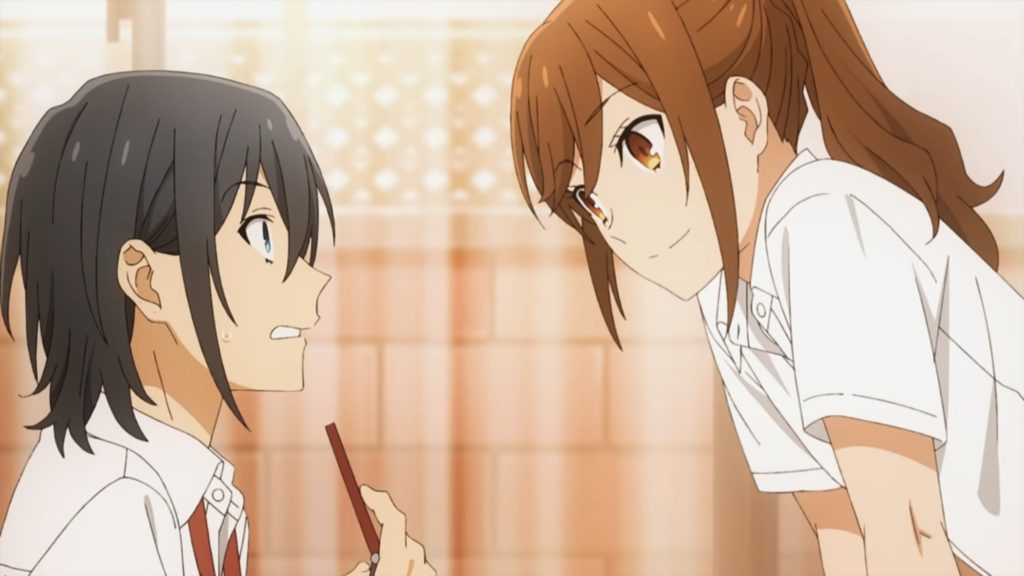
Three years after joining AniTAY, I’m beginning to think I’m not the romantic type. It’s peculiar because I came in right around the time when the genre was at an all-time high, with titles like Fruits Baskets and Kaguya-sama: Love is War becoming regular staples among the most casual of fans. Though I’ve learned to expect the unexpected with this year’s The Duke of Death and His Maid adding a layer of tragedy to its unusual premise and Komi Can’t Communicate going all in on the joke, the romantic comedy of the year was surprisingly the most grounded of the bunch!
Hiroki “Hero” Adachi’s original story Hori-san to Miyamura-kun has had an interesting road from web comic to manga and even a live action version the same year as its animated counterpart. Regardless of the version, Horimiya (Cloverworks) tells the story of Kyoko Hori and Izumi Miyamura, two high schoolers on complete opposite ends of the social spectrum. A chance encounter off campus leads to a shocking discovery, before realizing they share more than a few similarities. If this sounds like your traditional “boy meets girl” story, well, it is – until it isn’t. Rather than just rehash the age old “will they, won’t they,” Horimiya takes a shortcut and jumps straight into “nope, they totally are into each other!” It’s a small change that adds a thick layer of unpredictability to the romantic chemistry of our main pair, making for an abundant amount of humor, social awkwardness, and some genuinely tender moments.
But what sets Horimiya apart from its contemporaries is its grounded and mature approach to characters and dialogue. Despite taking place in a high school – I’m sure you can think of an anime to insert here – I had to do a double take multiple times to make sure I was still watching the same show. Archetypes and tropes might as well be foreign concepts because no character ever falls into the trap of feeling one dimensional or unsympathetic in their emotional burdens. Everyone has secrets and sides to them that they would rather not show to the world, and Horimiya’s multifaceted array of rainbow haired classmates and personalities pave the way for even greater character studies beyond its central main couple.
Many romance stories love to tease their audience on the path to the inevitable happily ever after. With its well written dialogue and aversion to conventional storytelling (while telling a traditional story!), Horimiya begins after that logical point, making for one of the best romantic comedies of the year.
8. Vivy: Fluorite Eye’s Song
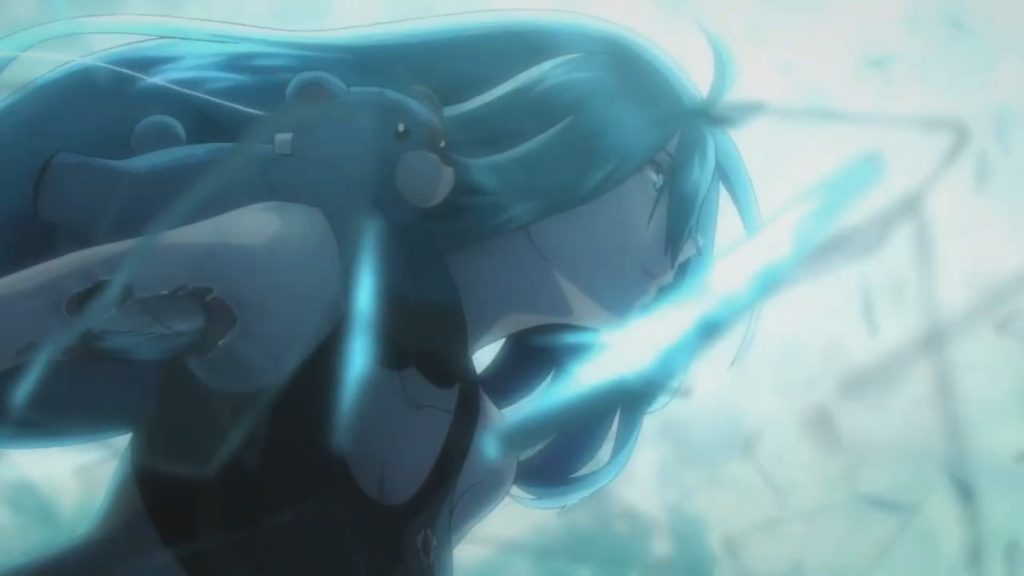
I was going to start this off section with a joke about not finishing Re:Zero Season 2 in time for this writing, but I’ve long since lost interest, so let’s talk about Vivy: Fluorite Eye’s Song! Co-written by Re:Zero’s Tappei Nagatsuki along with Eiji Umehara, Wit Studio’s next original anime following last year’s excellent Great Pretender managed to energize my senses with its beautiful animation, awe-inspiring sci-fi world, and evocative soundtrack. Though I spent 2021 covering many anime theme songs and adjacent soundtracks, Kairi Yagi’s soaring vocals as the titular android still remain as emotionally captivating as the day they first aired. From the heart pumping Sing My Pleasure to the magnum opus sharing the show’s title, Satoru Kōsaki’s (Beastars, Tekken 4 – 6) masterful composition is on full display, with the show utilizing numerous musical themes across the show’s 13 episode run.
I suppose now is the time to talk about the show itself. Set in a world where AI technology has advanced to the point that they have now become part of societal infrastructure and management, Vivy follows the songstress Diva, an AI who was given the mission to make people happy through her singing. As the first autonomous AI, her life’s purpose takes a dramatic turn when another AI from an alternate future makes contact, setting events in motion that will determine the fate of both humanity and the androids. From a critical perspective, it would be easy to draw comparisons to Re:Zero given that both utilize time travel as a story mechanic. Not unlike the way that series told a grander story through the conventions of fantasy and isekai, Vivy utilizes sci-fi and the threat of a technological apocalypse, making use of its protagonist’s robotic immortality for some truly diabolic levels of misdirection across multiple timelines.
Where it differs is the way it utilizes its main character’s motivations in service to its narrative. Unlike Re:Zero’s Subaru, Diva (or Vivy off-stage) has a purpose set in stone due to her programming. As the world’s first autonomous AI, however, the road to achieving her goal is paved with numerous obstacles as society is still on the cusp of their technological predicament. The price of free will, the value of human and sentient life, the purpose of having a role. Vivy continuously explores these concepts as she begins to question her own position the closer the doomsday clock arrives with each passing moment.
Whether it takes one or 100 years, Vivy: Fluorite Eye’s Song is a reminder that life is ultimately about the journey. Though some of us may never arrive at an answer, everyone has a story worth telling – all that’s left is for you to write it.
7. SK8 the Infinity
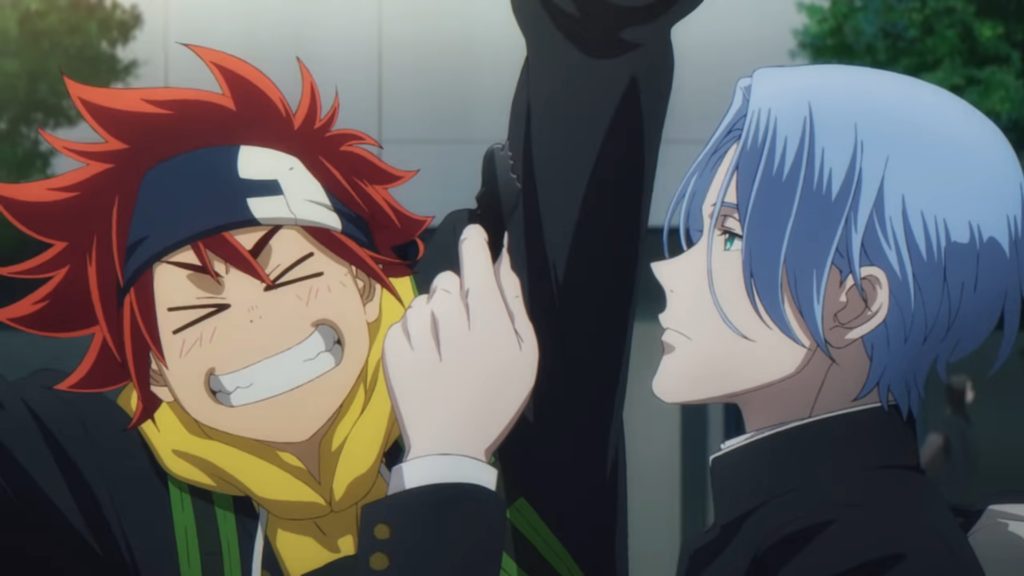
At the beginning of the year, if you would have told me that “Extreme Skateboarding” would be a prime contender for anime of the year, I would have knocked the cap off your head. Instead, studio Bones pulled a sick kick flip in such spectacular fashion with an original title I didn’t even know I wanted! Two best friends and rivals doing what they do best, a ridiculous number of over-the-top personalities and egos all vying to prove their worth, and a stylishly maddening heel (voiced by Takehito Koyasu no less!) come together to form the most insane sports tournament show of 2021.
Taking place in an underground circuit known as S, SK8 the Infinity follows the trials, triumphs, and tribulations of skateboarding enthusiast Reki Kyan and the new kid on the block Langa Hasegawa, who quickly hit it off when the former brings the latter into the world of skateboarding. As it so happens, Langa was quite the snowboarder in his homeland of Canada, who immediately finds a spark of adrenaline after getting a taste of S. Mixing sports drama with high octane action, SK8 shreds a shared lane between a battle tournament and the color commentary of something akin to Initial D.
While it treats the human aspect of the sport with a certain degree of realism, it’s really a playground to let Bones flex its wings. Characters that wouldn’t look out of place in a battle shonen with the attitudes to match, a series of high stakes and no-holds-barred matches highlighting some of the studio’s best work in recent years, and death defying tricks that got this non-sports fan pumping his fist more than once, SK8’s visual flair and pedigree are only matched by its equally compelling sports drama. Not everyone plays sports, much less competitively, but what is undeniable is passion. In my short time on this earth, I’ve held many passions only to give up on them as time went on. While my writing is currently at the forefront of my mind as I work on new content, I’d be lying if I said I didn’t have a ways to go – and I’ve been at this for almost six years now! For Reki and Langa, the passion of the sport is used to delve further into the relationship between doing something you love and the growing skill gap.
Like any creative outlet, SK8 the Infinity acknowledges the challenges to measure up to your passions. Sure, there will be missteps. Some will occasionally fall and most will probably quit. It’s a difficult, bumpy road with no guarantees. While few will break into their passion, you might find something else waiting – a community, a friend, or a helping hand or two. And who knows… You might even have fun.
6. Zombie Land Saga: Revenge
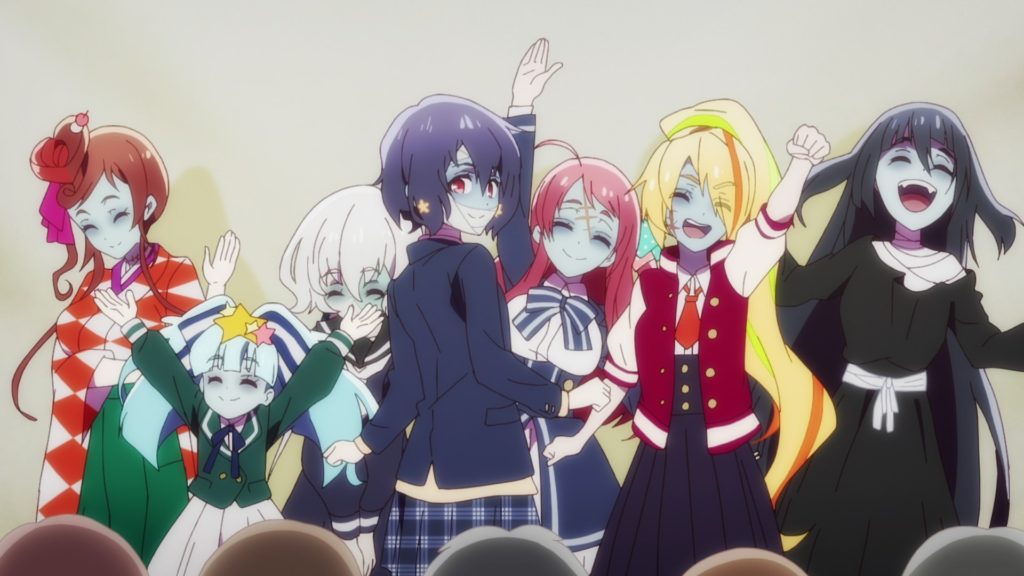
2021 can be called a lot of things, but if there was one welcome surprise I wasn’t expecting, it also proved to be the best sequel to 2018 – at least from an anime perspective. Sequels can be a tough act to follow, so when news broke that three of my favorite shows from that year would be returning, I couldn’t help but wonder what else there was to cover without retreading old ground. Fortunately, each came to the table prepared with a follow up that either surpassed the original, took the franchise in a new direction, or just decided to tear it all down in the best way possible. We’ll get to the first two later on, but for now, I’m talking about the sequel that came back with a vengeance.
When we last left off in 2018’s Zombie Land Saga, the undead idols of Franchouchou had mostly come into their own, overcoming their insecurities and personal grievances to band together and embrace their future. In Zombie Land Saga Revenge (MAPPA), the group finds themselves back at the bottom after a series of bad business decisions. While the Revenge moniker bills itself as something of a comeback tour, to simply call it a redemption story would be selling it short. Like the original, ZLS rarely settles into a comfortable rhythm or sticks with one idea for too long. One minute, you’ll get a deeply personal story that provides more insight into their previous lives, the next someone is competing in a breakdancing competition before limbs start coming off! I’ve never seen a show quite competently juggle comedy, drama, music, and the occasional misadventure, yet Revenge manages to rebound effortlessly while still holding its final trump cards for its grand finale.
Being an idol show, it should come as no surprise that the score and original music are still highlights with some outstanding solos in key episodes, as well as the banging new opening and ending themes. No less exceptional are the returning English cast who reprise their roles. Helmed by Jad Saxton, the original ZLS played host to a number of musical performances that were likely no easy feat recreating for dub audiences. Although the new songs in Revenge will likely come with the uncut home release, the wacky and colorful antics of the zombie group and support is taken to the logical extreme in Revenge through the performances of Brina Palencia (Sakura), Ricco Fajardo (Kotaro), Stephanie Young (Yugiri), and Sarah Wiedenheft (Lily) to name a few, along with Cherami Leigh who plays a new character that I’ll leave you to discover.
What I can spoil is that Zombie Land Saga Revenge obtained its sweet satisfaction in the end, as one of the best sequels of 2021. But I still haven’t because we’re only halfway through this list!
5. SSSS.Dynazenon
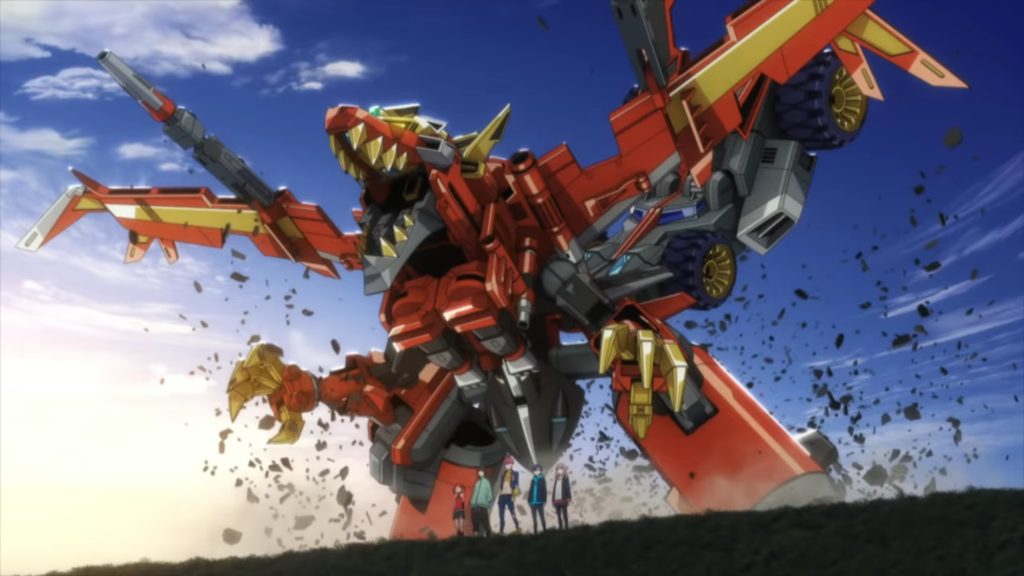
Now, I’ve made light of the fact here that I’m not really a kaiju person. Sure, I’ll dabble in the occasional monster movie or stories about people in tight spandex fighting aliens, but anime has never really been my most consistent choice in providing me those experiences. That all changed with 2018’s SSSS.Gridman which brought back the fun of mechs and monsters, but with a much more modernized spin on the tokusatsu genre through the art and animation of studio Trigger. It quickly became one of my favorite titles from the studio, as well as a runner up on my personal AOTY list before I started formally publishing these. As one of the few titles with a definitive ending, the idea of returning to the IP brought both excitement and trepidation in equal measure. How do you follow up such a carefully crafted story when its main narrative has concluded? Enter the Gridman Universe.
Rather than opt for a direct sequel, SSSS.Dynazenon tells an all new story with some connective tissue to its predecessor. Whereas SSSS.Gridman was clearer cut with its main antagonist, Dynazenon takes a completely different route by asking to what end our new protagonists fight for when they get unexpectedly drafted by a mysterious figure. For as much effort as team leader Gauma tries to assemble a team, the world doesn’t stop moving just because a giant monster is currently ravaging downtown! Being able to summon the mighty Dynazenon does very little to change each of its pilot’s personal lives. They go to work, have relationship problems or struggle with their own self-conflicts. Between all the monster bashing, there is an authentic layer of realism in the show’s actionless scenes and writing. A couple of my favorite moments have no dialogue whatsoever, just an awkward minute of silence before carrying on like nothing happened!
Bolstered by Trigger’s spot-on animation and Shirō Sagisu’s sweeping score, now all that’s left to answer is how does it compare to SSSS.Gridman? In writing this up, I still haven’t come up with a definitive way to answer this. Imperfect or not, SSSS.Dynazenon is less of a continuation and more of a reinvention for this planned universe. Though I expect most will form clearer opinions with the passage of time, it’s the kind of sequel that will no doubt spur a multitude of interpretations in the years to come. For those hearts and minds that did resonate with it, I’m sure you’ve noticed already. After all, scarred souls shine like stars.
4. Blue Period
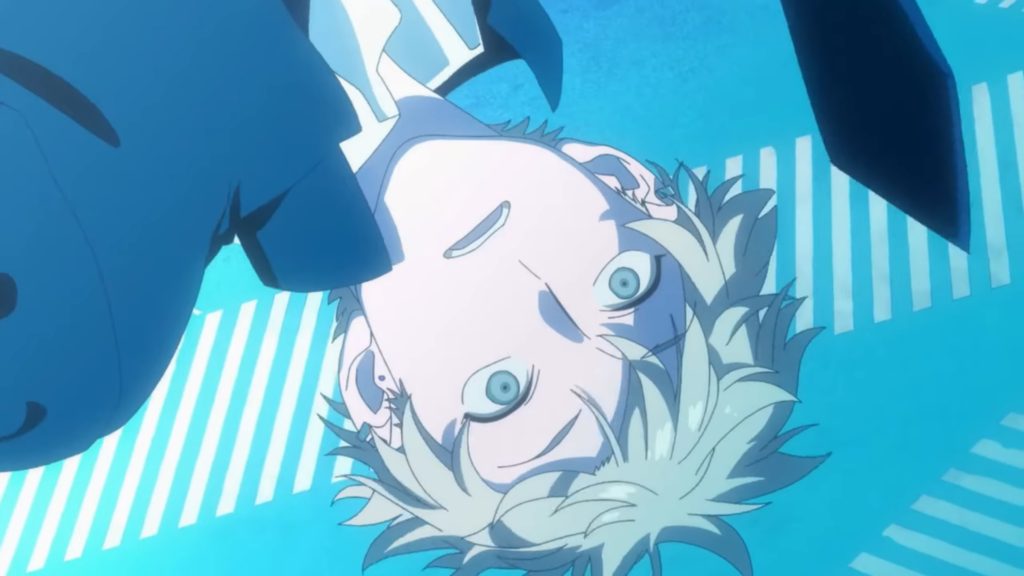
Many years ago, when I was still interning at my first gig, I learned very quickly on just how far my current skill level was. When I made the decision to pivot from my initial career choice, I had absolutely zero job experience. Even as I started learning the ropes, it always felt like I was trying to catch up to my peers. Call it a case of imposter syndrome, because that’s the feeling I most experienced while watching Blue Period (Seven Arcs) when I reminisce on my early career.
Based on the popular manga by Tsubasa Yamaguchi, it’s a coming-of-age story about an average boy who, after a brush of inspiration, decides to bet on himself and pursue professional art. It’s a simple, yet relatable premise that spins into a self-reflective journey about the real-life challenges of pursuing what you love. Unlike a lot of the shows on this list, Blue Period is firmly rooted in reality. Protagonist Yatora Yaguchi is perfectly competent at school work and has friends, yet finds his life lacking until the day he discovers art. He doesn’t have any special skills or talent, and there is no secret training or power ups here. His uphill battles come from everyday issues rather than fantasy. From being able to afford art school to emotional stress and rigorous practice beyond the classroom, Blue Period’s portrayal of the mundane and repetitive paints a disturbingly similar picture about the toll of self-sacrifice to achieve a dream.
The moment you commit to something and then realize just how far the wall is to where you want to be. The importance of figuring out your interests and develop your own style. The ability to honestly critique yourself and engage in other people’s work to better understand yours. Whether its art, writing, or whatever you fancy, these are the experiences and practices that encapsulate Blue Period’s understanding of the artist behind the art. It may not be the prettiest animated show on this list, yet it does little to diminish this beautiful still life that I can’t help but admire the dedication and craftsmanship behind it.
3. Kemono Jihen
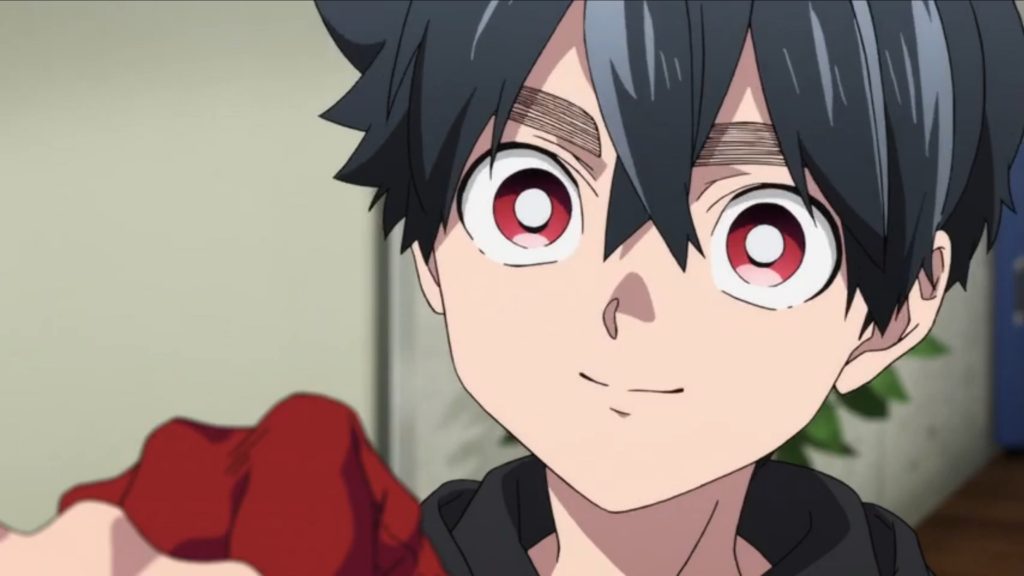
When it comes to shonen in 2021, Kemono Jihen (Ajia-do Animation Works) came as an unexpected surprise at the start of the year. A story about a detective agency solving mysteries revolving around monsters and folklore, a group of teens caught in the middle of human and demonic affairs, and an empathetic protagonist with an unusual power, it’s a supernatural tale that initially doesn’t stray too far from its roots. But beneath its innocent faces and combination of action, slice-of-life, comedy and horror, lies one of the most charming, mature and cleverly written shonen I’ve come across this year.
Following a messy upbringing, Kabane Kusaka gets taken in by private detective and tanuki Kohachi Inugami to work at his agency in Tokyo. Looking for answers about his origins, Kabane gets a second chance to experience life as he navigates the basics of emotion and connections while helping his fellow kemono overcome their own internal trauma. Child abuse, neglect, and exploitation, these kids have experienced some of the worst of humanity due to their status as kemono. In Kemono Jihen, overcoming that darkness is often more terrifying than the creatures brought to life by Ajia-do Animation Works. Coming from last year’s excellent Kakushigoto, the studio was more than qualified in portraying the day to day operations of the Inugami Strangeness Consultancy Office, but what I didn’t expect was just how well they would nail the show’s horror and action aesthetics. From everyday tranquility to the emotionally distressing and subsequent triumphs, the show’s presentation is only rivaled by Yuya Mori’s dynamic score.
Even more impressive is author Shō Aimoto’s take on familiar genre conventions to convey emotional and physiological pain. The bad boy and rival with a secret. The delicate, but passionate friend seeking true strength. The heroine not quite sure of her own heart. Nothing is entirely what it seems at first, and at the center of its greater mystery is its main protagonist. I’ve covered a lot of shonen protagonists here, yet Kabane truly is a category onto itself, while still remaining true to the genre’s foundation. Unusually soft-spoken and expressionless, but not without personality. Efficient and merciless when threatened, yet not without heart or compassion. Beneath his cool-headedness and direct approach, he just wants to find his parents. At a time when questions about the ideals of shonen or the genre’s nuanced character development have become routine, it’s a subject worth revisiting in its own article. But at the end of the day, if that’s not the heart of a shonen, the ideal the genre should be striving for, or the backbone that the medium deserves, then let’s look inward first.
A selfless act of kindness, courage in the face of absolute horror, and the preservation of life through the strength of others. These are all fine examples of Kemono Jihen’s layered approach to character building that’s further developed through the nuanced performances of Natsumi Fujiwara and Madeleine Morris in their respective sub and dub. Though my initial review was completed by the time the simuldub originally went live, ADR director Brittany Lauda and company did an impeccable job bringing the casual, trembling, and heartwarming moments together through Aimoto’s characters. With memorable performances from Patrick Seitz (Inugami), A.J. Beckles (Shiki), Cassie Ewulu (Akira), as well as the aforementioned Morris (Kabane) and Lauda (Kon), Kemono Jihen brings light into 2021’s darkness, delivering an evocative story about survivors in the face of real world horrors.
2. Megalo Box 2: Nomad
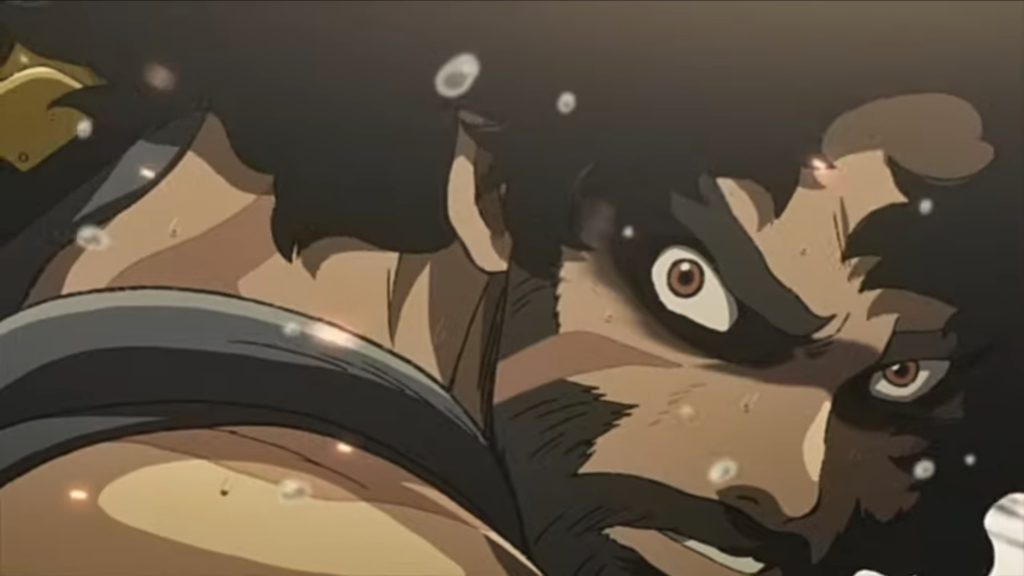
“Hey, have you ever heard the story about the hummingbird and the Nomad?”
Being a descendant of an immigrant family, you tend to grow up with a lot of different messages. Home, family, responsibilities and traditions, to name a few. If I had to describe that process, it’s a lot like learning to drive in reverse where you study the landmarks and street corners while you’re still getting accustomed to the controls – in Spanish (thanks dad!). That may not be the best analogy, but after a certain point, some things will inevitably fall through the cracks. When you hit rock bottom, it can feel like there’s no escape. Wrapping up the 2018 trilogy of sequels I didn’t think I needed, Megalo Box 2: Nomad (TMS Entertainment) begins at unexpected destination. Whereas the original Megalo Box followed a more traditional underdog story of Gearless Joe, its sequel moves the series forward several years later. Once again, the former champion returns to the underground arena under the name Nomad. Suffice to say, time has not been kind to Team Nowhere.
At a time when sequels can often feel like unnecessary cash grabs or obligatory franchise numbering, the original staff and writers had a lot of internal discussion and debates before entertaining the idea of a proposed sequel. While Joe’s character is still at the forefront of the story, a lot of time was given expanding the world outside of the ring, and it shows in the first four episodes. Even out in the desert plains of the unnamed town, the story of Gearless Joe struck a chord with the nearby immigrant population, including community leader and all around good guy Chief. As Joe begins picking himself up, we get a much more detailed look at the denizens and populace of unregulated zone. Though it was always evident where the lawless zone began and ended, Nomad does an incredible job fleshing out what was once just a background setting in season one to its own fully developed region with a history to explore.
Nomad’s previous cast also returns, just not the way you’re expecting. Joe may be the one on the cover, but time stopped for no one as the show checks up on them, continuously reminding him of the demons he has yet to resolve. Aside from Chief, Marla, and her son Mio, the other show’s new characters add additional nuance and dynamics to Joe’s new objective. But for my money, I have to give credit to up-and-coming boxer Mac “Mac Time” Rosario. What could have just been another climatic showdown between two men turns into one of the most relatable, if not likable stories of 2021. Hell, I even cheered, with more than one occasion finding myself rooting for his success.
Because I’d never live it down if I didn’t bring it up, Mabanua sets another high water mark for anime soundtracks with his impressive follow up, including one of the best openings of the year previously covered here. But just like its nomadic themes and TMS Entertainment’s old school animation aesthetics, we can’t all go back to our old homes. Megalo Box 2: Nomad teaches us that it’s okay to fall down. Even if you don’t have a home, it’s never too late to build a new one.
1. Odd Taxi
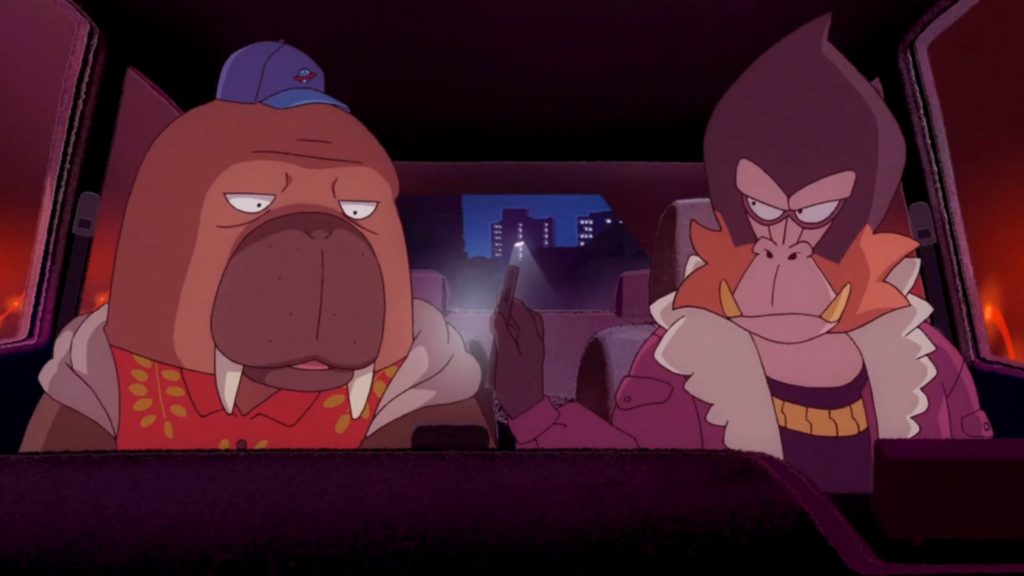
What does a taxi driver, an idol group, a comedy duo, an online streamer, cops, and a rapping Yakuza all have in common? Well, if you’re still reading this and you didn’t just skim all the way to the bottom (you fiend), then you already know where this is going. Produced by OLM and P.I.C.S., Odd Taxi is anime that probably needs no introduction. Critically acclaimed, winner of more than a few individual anime of the year lists including #1 on AniTAY’s Top Anime of 2021, and of course, my very own official anime of the year. I could probably wrap things up right about here, but I’ve already put in my overtime on this list, so what’s one more trip?
Debuting in quite possibly the busiest season of last year, Odd Taxi had a very unusual (no pun intended) inception. An original anime from a first time writer and director co-animated by two studios, this animal-themed story takes us behind the backseat of taxi driver Hirosho Odokawa and the various citizens around Tokyo. What begins as a slow evening with the usual round of patrons quickly descends into a mystery box when the police suddenly come knocking on Odokawa’s door. A high school girl gone missing, a criminal syndicate seemingly going around asking questions, and a number of ordinary folk who just happened to share a taxi ride with a certain driver, these becoming the starting points before the show turns into a merry-go-round of secrets. Not to explore exactly whodunit, but rather what was happening during that time in question.
Think closely about your typical day. How do you start? What is your typical routine? Who did you interact with? Did anything strange happen that day? What thoughts were racing in your mind? In life, even the smallest of actions can have a ripple effect. By having multiple characters tell and retell the story from another angle, it calls to mind the myriad of choices we make routinely. While Odd Taxi is not the first anime or even visual medium to make use of this type of storytelling device, its implementation is by far one of the most realized. Starting with a day in the life of Odokawa, we come to meet the 41-year-old taxi driver who lives an ordinary, but socially detached lifestyle.
Other than the animal aesthetic, what’s most interesting about this pilot is it plays everything completely straight. There are no gimmicks or tropes applied to get a point across. Everything we learn comes directly from Odokawa’s conversations and the environment. The radio station playing in his taxi, the awkward conversation with a college student about the Internet, Bruce Springsteen (yes, it gets weird!), it’s the simple mind trick of making normal conversation and observation flow effortlessly that Odd Taxi consistently gets right. The fact that it doesn’t need to come full stop after a big twist or tell the audience directly shows a very high level of confidence with the writing chops to back up its bite.
Equally as telling is its intrinsic cast of characters. Apart from walrus man Odokawa (played by an unusually grim Natsuki Hanae!), Odd Taxi bounces into even stranger territory with its anthropometric citizens. From an alpaca nurse who practices in capoeira, a burnt-out game developer puma with a mobile game addiction, a white-gibbon with a knack for overselling himself, and yes, a rapping porcupine gangster, each additional character adds another layer to Odd Taxi’s overall narrative, while spinning an interesting story in and of itself. In the show’s 13 episodes, not a single moment is wasted on unnecessary filler or padded in to kill time. While some stories branch out from the main plot, all of them are given enough time to make their own mark and come to some form of closure or self-discovery. At a time when so many projects end up either compromising or finishing with half-hearted finales, it’s refreshing to see a show carry on to the very end, telling an intimate story while sticking to its overall direction.
Everyone has a story to tell. Perhaps you’re an Odokowa or share drinks with a real-life Eiji. Maybe you’ve had run-ins with the local meerkat cops or know the baboon criminal. You might even employ the services of a gorilla doctor or listen to the latest single from an unknown pop trio. Odd Taxi is all about the weirdos we come across. From everyday workers to shady characters and all manner of questionable people we can’t get away from, it’s a show about the animal inside us all.
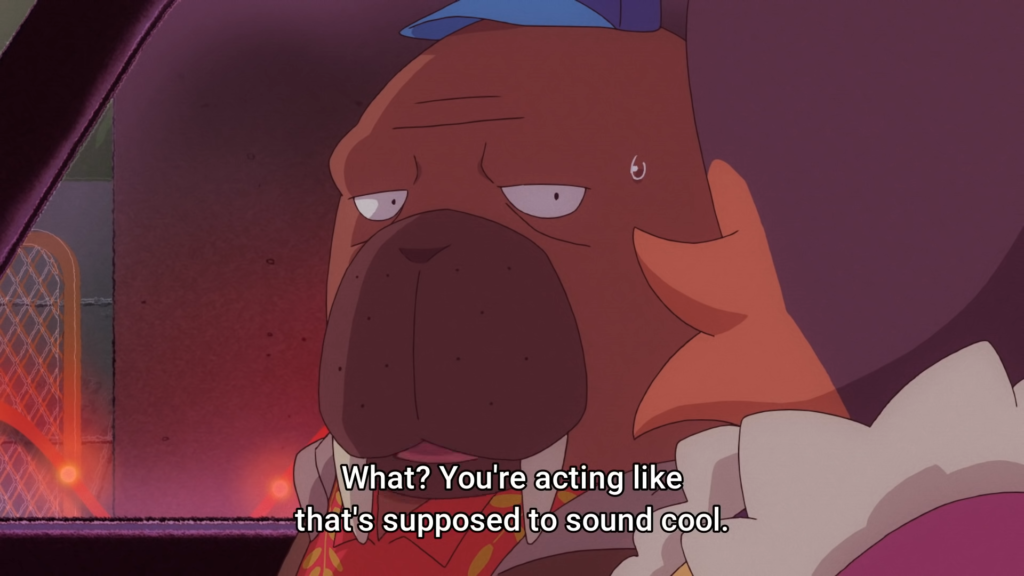
Once again, congrats to OLM, P.I.C.S., and the winners of this year’s top 10! I’ll be taking a breather for the next couple weeks while I plan ahead. As always, a special thanks to our communities at TAY and AniTAY for letting me host these and our readers for indulging this weird hobby of ours.
Until next time, see ya!
Credits:
Song: ODDTAXI (The First Take)| Artist: Skirt and DJ PUNPEE | Anime: ODDTAXI
Dark Aether is a writer/contributor for TAY and AniTAY. You can check his previous writings on TAY2, Medium, or follow him on Twitter @TheGrimAether. Not Dead Yet.
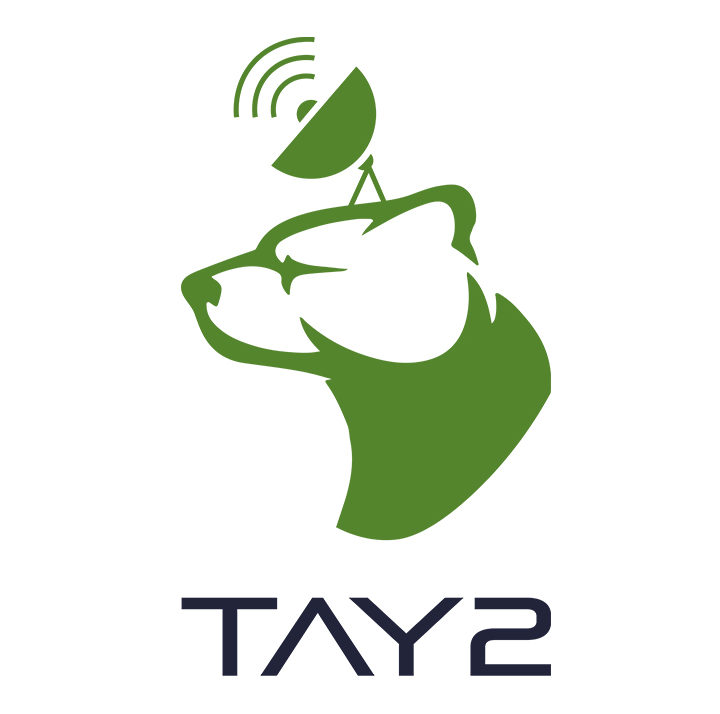

Get involved!
Comments